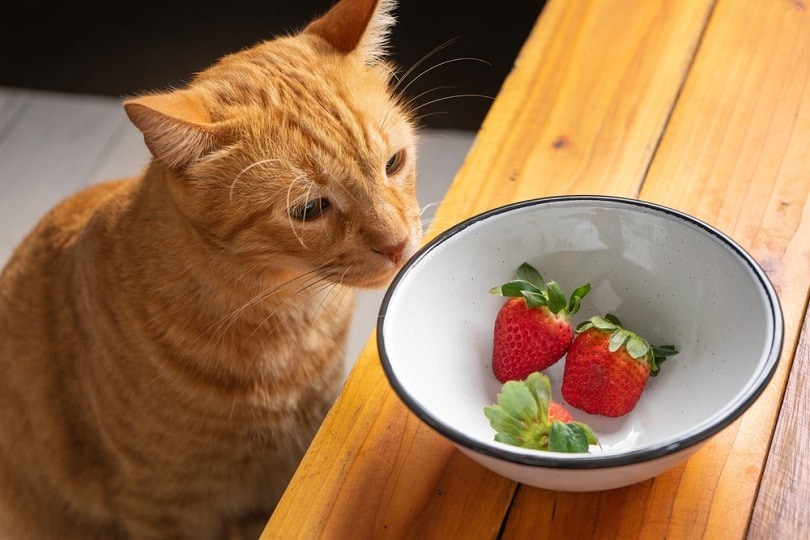Click to Skip Ahead
Cats often appear to have a slim selection of foods they’ll eat, which can make it seem surprising when they greedily munch down a fresh strawberry. Though we may not expect it, we also don’t need to worry, as cats can eat strawberries without any adverse effects.
But tolerable doesn’t mean healthy. Although strawberries may positively impact our bodies, they don’t have the same benefits for an obligate carnivore like a cat. If you’re trying to add these tasty treats to your pet’s diet, we’ll explore if cats can eat strawberries or if you should leave them off the menu.
Can Cats Eat Strawberries?
Cats can eat a strawberry without much issue, but there’s little point in including them in their diet. While strawberries aren’t toxic, the nutritional aspects don’t benefit cats as much as humans. If cats eat too many, the sugars can cause GI upset, leading to nausea, diarrhea, or vomiting.
Do Cats Like Strawberries?
A cat’s curiosity may lead them to try a strawberry, but you probably won’t have to worry about them eating an entire package. While cats can sense sour, bitter, and salty flavors, they can’t taste sweetness. When your cat tries a strawberry, they likely won’t enjoy it enough to pursue it in the future.
Interestingly, some theorize that the scent of strawberries attracts cats in a way similar to catnip. But although you may find your cats weirdly drawn to rubbing their heads against a basket of fruit, they still stand a slim chance of overeating.

Are Strawberries Good for Cats?
Strawberries are over 90% water, while most of the remainder are simple carbs, namely glucose and fructose. Strawberries support the immune system and heart health through a slew of vital nutrients, including:
- Fiber
- Vitamin A
- Vitamin C
- Folate
- Potassium
- Manganese
While that’s significant for omnivorous humans needing a well-rounded diet, those nutrients don’t have much impact on meat-eating cats. For example, although the simple monosaccharides in strawberries are more absorbable and usable than complex carbs, cats on a healthy diet ably manage their glucose levels through gluconeogenesis.
Likewise, vitamin C is a critical dietary component for humans that strawberries provide in abundance. But again, animals like cats and dogs synthesize ascorbic acid in the liver, removing a need to supplement it in the diet.
That isn’t to say cats receive zero benefits from strawberries, as many nutrients like fiber, calcium, and potassium are vital to their health. But if cats eat an appropriate daily portion of quality cat food, they already fulfill all their dietary needs. Besides, the few strawberries they can reasonably eat wouldn’t provide many health benefits.

What Happens If Cats Eat Too Many Strawberries?
The primary concerns with a cat getting into strawberries are overeating and the choking hazards of uncut pieces. Strawberries have a low glycemic index and are unlikely to spike a cat’s blood sugar levels. Still, an overabundance of sugars can build up in the intestines. Over time, the fermenting substrate will promote harmful bacteria growth, causing upset bowels.
Despite the limited adverse effects on healthy pets, diabetic cats should avoid strawberries. Moderate strawberry consumption won’t cause severe health concerns, but at-risk cats are better off with a diet higher in protein and lower in carbs.
How To Feed Your Cat Strawberries
If your cat is showing an overwhelming desire to eat a strawberry, there’s typically no harm in giving them a small taste. Only feed your cat a strawberry or less daily, offering no more than a couple per week.
Wash strawberries thoroughly to remove contaminants, and remove the leaves before cutting the berry into small, bite-sized pieces to prevent the risk of choking. Present it to your cat, and let them decide how to proceed.

Final Thoughts
Cats can eat strawberries in moderation and with proper preparation. Some cats are intolerant to them, and you should monitor for any ill effects that might stem from overconsumption. Regardless, strawberries should only be served as treats for cats. They don’t fill any nutritional gaps and can even be harmful in high quantities. Don’t sweat it when your cat has a berry, but also don’t feel obligated to share a taste of your summer fruit mixes with your pet.
Featured Image Credit: Olha Shato, Pixabay











